计算机英语文本文档
英语 文本文档
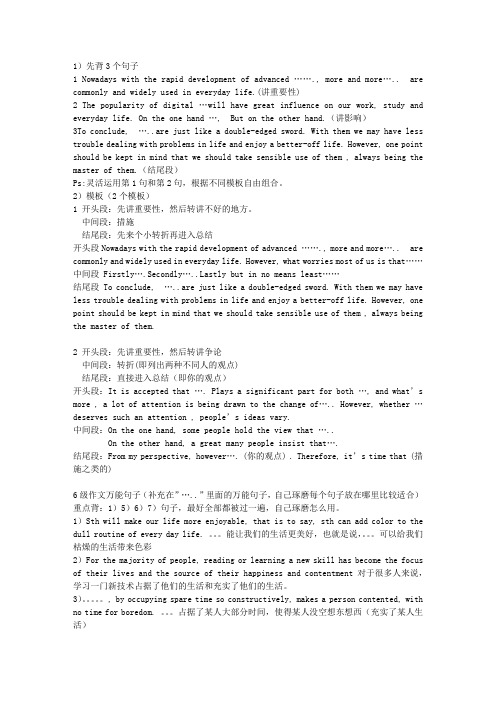
1)先背3个句子1 Nowadays with the rapid development of advanced ……., more and more….. are commonly and widely used in everyday life.(讲重要性)2 The popularity of digital …will have great influence on our work, study and everyday life. On the one hand …, But on the other hand.(讲影响)3To conclude, …..are just like a double-edged sword. With them we may have less trouble dealing with problems in life and enjoy a better-off life. However, one point should be kept in mind that we should take sensible use of them , always being the master of them.(结尾段)Ps:灵活运用第1句和第2句,根据不同模板自由组合。
2)模板(2个模板)1 开头段:先讲重要性,然后转讲不好的地方。
中间段:措施结尾段:先来个小转折再进入总结开头段Nowadays with the rapid development of advanced ……., more and more….. are commonly and widely used in everyday life. However, what worries most of us is that……中间段 Firstly….Secondly…stly but in no means least……结尾段 To conclude, …..are just like a double-edged sword. With them we may have less trouble dealing with problems in life and enjoy a better-off life. However, one point should be kept in mind that we should take sensible use of them , always being the master of them.2 开头段:先讲重要性,然后转讲争论中间段:转折(即列出两种不同人的观点)结尾段:直接进入总结(即你的观点)开头段:It is accepted that …. Plays a significant part for both …, and what’s more , a lot of attention is being drawn to the change of….. However, whether …deserves such an attention , people’s ideas vary.中间段:On the one hand, some people hold the view that …..On the other hand, a great many people insist that….结尾段:From my perspective, however…. (你的观点) . Therefore, it’s time that (措施之类的)6级作文万能句子(补充在”…..”里面的万能句子,自己琢磨每个句子放在哪里比较适合)重点背:1)5)6)7)句子,最好全部都被过一遍,自己琢磨怎么用。
电脑的英语作文带翻译
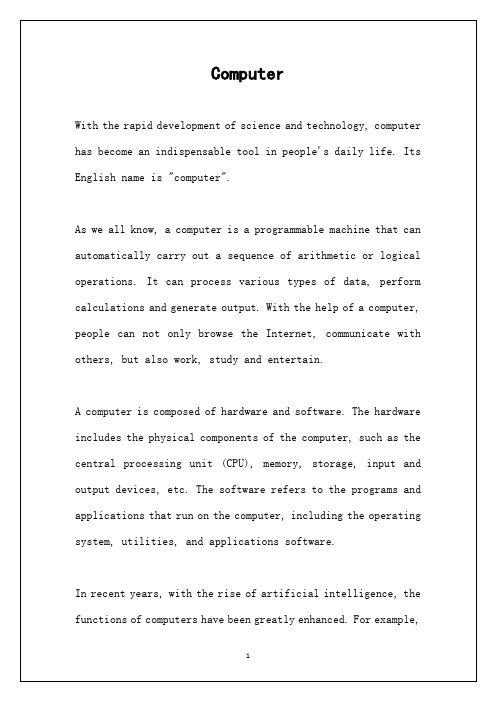
近年来,随着人工智能的兴起,电脑的功能得到了极大的增强。例如,语音识别、人脸识别和机器学习已广泛应用于各个领域,为人们的生活带来了极大的便利。
在教育方面,电脑彻底改变了学生学习的方式。在电脑的帮助下,学生可以访问互联网上大量的信息和资源,这使他们更容易进行研究和学习。此外,还有各种教育软件和应用程序,为学生提供了互动和有趣的学习体验。
电脑
随着科学技术的迅猛发展,电脑已经成为人们日常生活中不可或缺的工具。它的英文名为"computer"。
众所周知,电脑是一种可编程的机器,可以自动执行一系列算术或逻辑操作。它可以处理各种类型的数据,进行计算并生成输出。在电脑的帮助下,人们不仅可以浏览互联网,与他人交流,还可以工作、学习和娱乐。
电脑由硬件和软件组成。硬件包括计算机的物理组件,如中央处理单元(CPU)、内存、存储器、输入和输出设备等。软件是指在计算机上运行的程序和应用程序,包括操作系统、实用程序和应用软件。
In terms of education, computers have revolutionized the way students learn. With the help of computers, students can access a vast amount of information and resources on the Internet, which makes it easier for them to conduct research and study. In addition, there are various educational software and applications that provide interactive and engaging learning experiences for students.
关于计算机的英语文章

关于计算机的英语文章随着现代信息技术的迅猛发展,计算机已经广泛地应用到社会的各行各业,人们渴望学习这种“人类通用智力工具”。
下面是店铺带来的关于计算机的英语文章,欢迎大家阅读!关于计算机的英语文章篇一系统软件Software refers to computer programs. Programs are the instructions that tell the computer how to process data into the form you want. There are two kinds of software: system software and application software.软件指的是计算机程序。
程序是告诉计算机如何将数据处理成你想要的形式的指令。
有两种软件:系统软件和应用软件。
System software is a collection of programs that enables application software to run on a computer system's hardware devices, it is background software and includes programs that help the computer manage its own internal resources.系统软件是指能让应用软件在计算机系统硬件设备上运行的程序的集合,它是后台软件并且包括帮助计算机管理自己内部资源的程序。
Application software is a specialized programs that enables the user toaccomplish specific tasks.应用软件是让用户能够完成特定任务的专门程序。
In this text, we mainly discuss system software.System software consists of four kinds of programs: bootstrap loader, diagnostic routines, basic input-output system, and operating system. Among these four parts, the operating system is we most concerned with, whith helps manage computer resources. Most important operating systems are: Windows, Windows NT, OS/2, Macintosh, and Unix.在这一节中,我们主要讨论系统软件。
计算机类的英语作文模板

计算机类的英语作文模板Computer Science is a rapidly growing field that has changed the way we live and work. It is a field that combines theory, programming, and engineering to create innovative solutions to problems. In this essay, I will discuss the basics of computer science and its importance in today's world.Firstly, computer science is the study of computers and computational systems. It involves the design, development, and analysis of software and hardware used in computing. The field covers a wide range of topics, including algorithms, programming languages, data structures, computer networks, artificial intelligence, and computer graphics.Secondly, computer science is important because it has revolutionized the way we live and work. It has made communication easier and faster through the use of email, instant messaging, and social media. It has also made itpossible to access information from anywhere in the world through the internet. Additionally, computer science hasled to the development of new industries, such as e-commerce, online gaming, and mobile app development.Thirdly, computer science has a significant impact on the economy. It has created new job opportunities and has increased productivity in many industries. For example, the use of automated systems has made manufacturing more efficient, while the use of computerized systems has made accounting and finance more accurate and faster.In conclusion, computer science is an important field that has changed the way we live and work. It has revolutionized communication, access to information, andhas created new industries. It has also had a significant impact on the economy, creating new job opportunities and increasing productivity. As technology continues to advance, the field of computer science will continue to play a vital role in shaping our world.。
电脑英语名词简释 文本文档 (2)
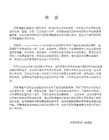
一 著名计算机公司
Microsoft: 有时缩略为MS,是全球最著名的软件商,美国软件巨头微软公司的名字。Microsoft其实是由两个英语单词组成:Micro意为“微小”,Soft意为“软的”,此处应为“Software,软件”,顾名思义,微软(Microsoft)是专门生产软件的公司。当今90%以上的微机都是装载Microsoft的操作系统,如MS-DOS 6.22、Windows 3.2、Windows 95、Windows NT等。
PCI:Peripheral Component Interconnection,局部总线( 总线是计算机用于把信息从一个设备传送到另一个设备的高速通道)。PCI总线是目前较为先进的一种总线结构,其功能比其他总线有很大的提高,可支持突发读写操作,最高传输率可达132Mbps,是数据传输最快的总线之一,可同时支持多组外围设备。PCI不受制于CPU处理器,并能兼容现有的各种总线,其主板插槽体积小,因此成本低,利于推广。
AMD:世界第二大CPU制造商,主要产品有K5,K6 MMX CPU系列。
Cyrix:CPU制造商,主要产品有M1,M2 MMX CPU系列。
Epson:爱普生,日本爱普生打印机制造商。
HP:惠普,Hewlett Packard的缩写,是美国著名的惠普打印机、电脑制造商。
Canon:佳能,著名打印机商标。日本著名的佳能打印机制造商。Canon英文意思为“宗教法规,标准”,可以看出佳能公司在创业之初,就决心要把自己的产品作为业界的“标准”。
Windows:在一般英文字典中查到Windows的意思为“窗户”。Window指微软公司(Microsoft)著名的新一代电脑主流“视窗操作系统”。它通过一些图形图标(Icon)、窗口(Window)和菜单(Menu)等的选择来实现对计算机的控制,极大地方便了用户。Windows视窗操作系统系列产品有Windows 3.1、Windows 3.2、Windows 95(因为该产品是1995年出品,因而取名为Windows 95,也可写成Win95。PWindows 95指中文版本的Windows 95),而功能更强大的最新产品为Windows 98和Windows 2000等。Windows 95是目前最著名、最受欢迎的图形化操作系统之一。
英语word文档

英语Word文档:掌握高效办公的必备技能一、认识英语Word文档的重要性二、英语Word文档的基本操作1. 新建文档:启动Word软件,“新建”按钮,选择“空白文档”开始编辑。
2. 设置文档格式:在“页面布局”选项卡中,可以调整纸张方向、页边距、分栏等参数。
3. 输入文本:在编辑区域直接输入英文内容,注意使用正确的单词拼写和语法。
4. 字体和段落设置:通过“字体”和“段落”选项卡,调整字体、字号、颜色、行间距等。
5. 插入和目录:使用“插入”选项卡中的“”功能,为文档添加层次分明的。
完成后,可自动目录。
三、英语Word文档的高级应用1. 查找和替换:利用“查找和替换”功能,快速定位并修改文档中的错误内容。
2. 批注和修订:在审阅他人文档时,可以使用批注功能提出建议,通过修订功能展示修改痕迹。
3. 图片和图表插入:在文档中插入相关图片和图表,使内容更加生动直观。
4. 表格制作:通过插入表格,整理数据和信息,便于阅读和分析。
5. 文档保护:为防止他人修改文档,可以设置密码保护或限制编辑权限。
四、提升英语Word文档排版技巧1. 统一字体和字号:确保全文字体和字号的一致性,提升文档的专业度。
2. 合理运用层级:通过设置不同层级的,使文档结构清晰。
3. 段落间距调整:适当调整段落间距,使文档内容更加紧凑。
4. 首行缩进:为段落设置首行缩进,增强文档的阅读体验。
5. 页眉和页脚:添加页眉和页脚,完善文档的版式设计。
五、英语Word文档的协作与共享1. 实时协作:利用Word的实时协作功能,邀请团队成员共同编辑文档,提高工作效率。
2. 文档共享:将文档保存到云端,如OneDrive、Google Drive 等,方便团队成员随时随地访问和编辑。
3. 评论交流:在文档中添加评论,与团队成员进行沟通交流,确保信息传递畅通。
4. 版本控制:通过Word的版本历史功能,查看文档的修改记录,确保重要内容不丢失。
六、英语Word文档的打印与输出1. 预览打印效果:在打印前,使用“打印预览”功能查看文档的整体效果,避免出现排版问题。
电脑相关英文作文
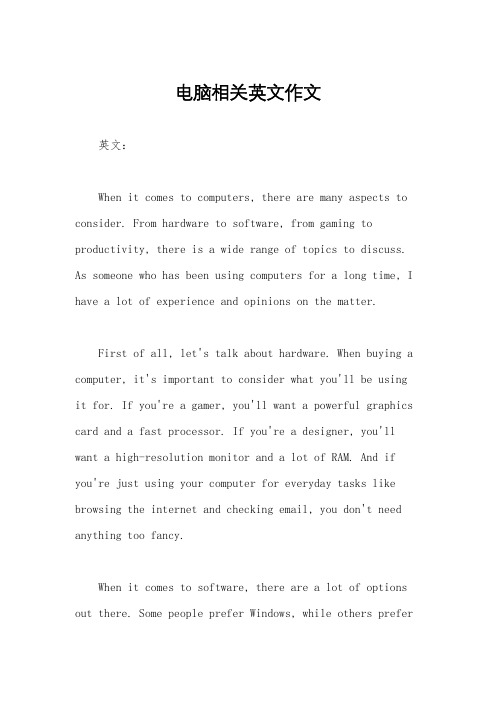
电脑相关英文作文英文:When it comes to computers, there are many aspects to consider. From hardware to software, from gaming to productivity, there is a wide range of topics to discuss. As someone who has been using computers for a long time, I have a lot of experience and opinions on the matter.First of all, let's talk about hardware. When buying a computer, it's important to consider what you'll be using it for. If you're a gamer, you'll want a powerful graphics card and a fast processor. If you're a designer, you'll want a high-resolution monitor and a lot of RAM. And if you're just using your computer for everyday tasks like browsing the internet and checking email, you don't need anything too fancy.When it comes to software, there are a lot of options out there. Some people prefer Windows, while others preferMac OS or Linux. It really depends on your personal preference and what you're used to. Personally, I prefer Windows because it's what I've been using for years and I'm comfortable with it. However, I know plenty of people who swear by Macs and wouldn't use anything else.One thing that's important to consider when it comes to software is security. You want to make sure that you have a good antivirus program installed and that you're keeping your operating system and other software up to date. There are a lot of threats out there, and you don't want to leave yourself vulnerable.Another aspect of computers that's worth discussing is gaming. There are a lot of great games out there, and playing them on a computer can be a lot of fun. However, you need to make sure that your computer is up to the task. You'll want a powerful graphics card, a fast processor, and plenty of RAM. And you'll also want to make sure that you have a good gaming mouse and keyboard.Finally, let's talk about productivity. Whether you'rea student, a freelancer, or an office worker, there are a lot of tools out there that can help you get things done. From word processors to project management software,there's something for everyone. Personally, I use Microsoft Office for most of my work, but I know plenty of people who prefer Google Docs or other alternatives.In conclusion, computers are a complex and multifaceted topic. There are a lot of factors to consider when buying a computer or using one for work or play. However, with a little bit of research and some trial and error, you can find the right computer and software for your needs.中文:说到电脑,有很多方面需要考虑。
计算机部件英语作文初一

计算机部件英语作文初一Computer Components。
A computer is a complex machine that is made up of many different components. Each of these components plays a critical role in the functioning of the computer. In this article, we will take a closer look at some of the most important computer components.Motherboard。
The motherboard is the central component of a computer. It is the main circuit board that connects all of the other components together. The motherboard also contains the processor, which is the brain of the computer. Without a motherboard, a computer would not be able to function.Processor。
The processor, also known as the central processingunit (CPU), is the brain of the computer. It is responsible for executing instructions and performing calculations. The speed and power of the processor determine how fast the computer can perform tasks.Memory。
计算机的英语作文

计算机的英语作文Title: Computer A Revolution in Modern Technology。
The invention of the computer has undoubtedly revolutionized the modern world. From its humble beginnings as a simple calculating machine to its current status as an indispensable tool in nearly every aspect of our lives, the computer has come a long way.The computer, in its simplest form, is a device that can perform various tasks by following a set of instructions. These tasks can range from simplecalculations to complex data analysis and everything in between. The ability of the computer to process information at incredible speeds has made it an invaluable tool in fields such as engineering, medicine, finance, and many others.One of the most significant impacts of the computer is its role in communication. With the advent of the internet,the world has become more interconnected than ever before. People from different corners of the globe can now communicate with each other in real-time, share information, and collaborate on projects. This has led to a significant increase in global productivity and has opened up new opportunities for business, education, and social interaction.The computer has also revolutionized the way we access and consume information. With the rise of the internet, a vast amount of knowledge is now just a few clicks away.This has democratized education and made it possible for people from all walks of life to access resources that were previously only available to a select few. Additionally,the computer has changed the way we entertain ourselves,with streaming services, online gaming, and social media becoming integral parts of our daily lives.In the field of medicine, the computer has played a crucial role in advancing research and improving patient care. Medical imaging, data analysis, and patient records are now all stored and processed using computer technology,leading to more accurate diagnoses and better treatment outcomes. The computer has also enabled the development of new medical devices and procedures that have saved countless lives.In the business world, the computer has streamlined operations, improved efficiency, and opened up new markets. From small businesses to multinational corporations, the computer is used to manage inventory, process transactions, analyze data, and communicate with customers and suppliers. This has led to increased productivity and profitabilityfor businesses of all sizes.Looking to the future, the computer continues to evolve at a rapid pace. Advances in artificial intelligence, quantum computing, and other emerging technologies promise to further revolutionize the way we live and work. It is clear that the computer will continue to play a centralrole in shaping the future of humanity.In conclusion, the computer has had a profound impact on the modern world. Its ability to process information,facilitate communication, and drive innovation has transformed nearly every aspect of our lives. As we look to the future, it is certain that the computer will continue to be at the forefront of technological advancement,driving progress and shaping the world for generations to come.。
计算机编程英语:(手摘)
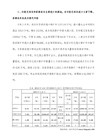
Class variable 类变量
Constructor 构造方法
classpath 类路径
Core:核心
count 计数
client 客户
code 代码
calculation 计算
cell 单元
check 检查
编程英语:(手摘)-水木清华
AAAAAAAAAAAAAAAAAAAAAAAAAAAAAAAAAAAAAAAAAAAAAAAAAAAAAAAAAAAAAAAAAAAAAAAAAAAAAAA
abstract (关键字) 抽象 ['?bstr?kt]
access vt.访问,存取 ['?kses]'(n.入口,使用权)
associated 相应的、相关的 相关的、关联、相应的
associative container 关联式容器(对应 sequential container) 关联式容器
atomic 不可分割的 原子的
active 作用中的
adapter 配接器 适配器
address 位址 地址
CCCCCCCCCCCCCCCCCCCCCCCCCCCCCCCCCCCCCCCCCCCCCCCCCCCCCCCCCCCCCCCCCCCCCCCCCCCCCCC
controller:控制器
call n.v.调用; 呼叫; [k?:l]
Class :类
concept 概念
circumstance n.事件(环境,状况) ['s?:k?mst?ns]
access function 存取函式 访问函数
activate 活化 激活
为客人介绍计算机作文英文

为客人介绍计算机作文英文英文:As a computer enthusiast, I would like to introduce the computer to you. Computers are electronic devices that can perform a variety of tasks, such as word processing, internet browsing, and gaming. They consist of hardware components, such as the central processing unit (CPU), memory, and storage, as well as software programs that enable users to interact with the machine.Computers have become an essential part of our daily lives. For example, I use my computer to communicate with friends and family through social media and email. I also use it for work, as I can easily create documents, spreadsheets, and presentations. Additionally, I enjoy playing video games on my computer in my free time.In terms of hardware, computers come in various forms, including desktops, laptops, and tablets. Each type has itsown advantages and disadvantages. For example, desktops are typically more powerful and have larger screens, while laptops are portable and convenient for on-the-go use.In terms of software, there are countless programs available for different purposes. For instance, I use Microsoft Office for my work-related tasks and Adobe Photoshop for photo editing. There are also web browserslike Google Chrome and Mozilla Firefox for internet surfing.Overall, computers have greatly improved our efficiency and productivity. They have revolutionized the way we work, communicate, and entertain ourselves. I believe that computers will continue to play a crucial role in our lives in the future.中文:作为一个热爱计算机的人,我想向你介绍一下计算机。
英语作文电脑模板
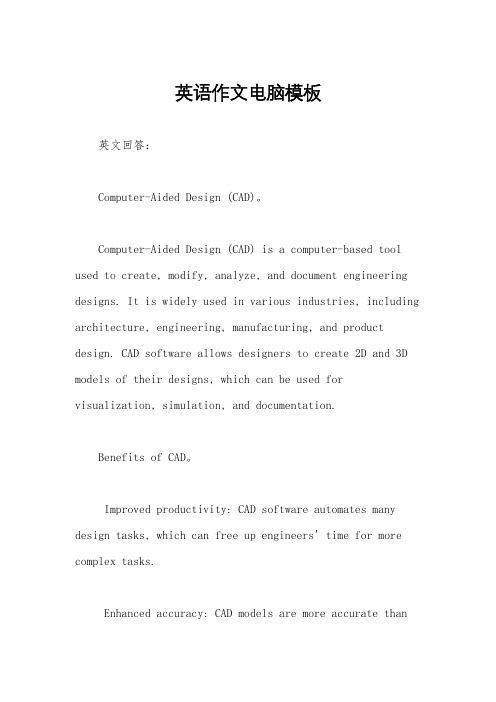
英语作文电脑模板英文回答:Computer-Aided Design (CAD)。
Computer-Aided Design (CAD) is a computer-based tool used to create, modify, analyze, and document engineering designs. It is widely used in various industries, including architecture, engineering, manufacturing, and product design. CAD software allows designers to create 2D and 3D models of their designs, which can be used for visualization, simulation, and documentation.Benefits of CAD。
Improved productivity: CAD software automates many design tasks, which can free up engineers' time for more complex tasks.Enhanced accuracy: CAD models are more accurate thanhand-drawn designs, which can reduce errors in the manufacturing process.Better visualization: CAD software allows designers to create realistic 3D models of their designs, which can help them better understand how the design will function in the real world.Improved collaboration: CAD software makes it easier for engineers to collaborate on designs, as they can share and modify models over a network.Reduced costs: CAD software can help reduce costs by automating tasks, reducing errors, and improving design efficiency.Types of CAD Software。
计算机英语作文模板

计算机英语作文模板英文回答:Computer: A Modern Marvel。
The computer, an indispensable tool in today's world, has revolutionized the way we live, work, and interact with information. Its rapid evolution has transformed it from a mere calculating machine to a versatile device capable of performing countless tasks that were previously unimaginable.The Genesis of the Computer。
The origins of the computer can be traced back to the abacus, an ancient counting device invented thousands of years ago. In the 19th century, the development of mechanical calculators marked a significant milestone in computing history. However, it was the advent of electronic computers in the mid-20th century that truly ushered in themodern era of computing.Evolution of Computing。
The introduction of transistors in the 1950s miniaturized computer components, enabling the development of smaller and more powerful machines. The invention of the integrated circuit (IC) in the 1960s further accelerated the miniaturization process, paving the way for the personal computer revolution of the 1970s.Today, computers have become ubiquitous in our lives. From the desktop computers that sit on our desks to the smartphones that we carry in our pockets, they are an essential part of our personal, educational, and professional pursuits.Impact of Computers。
计算机常用英语词汇表完整

计算机常用英语词汇表(可以直接使用,可编辑实用优秀文档,欢迎下载)计算机常用英语词汇表高频700单词一、硬件类(Hardware) ('hɑ:dwεə)CPU(Center Processor Unit)中央处理单元('sentə'prəusesə'ju:nit)Main board主板(meinbɔ:d)RAM(random access memory)随机存储器(内存)('rændəm'ækses'meməri)ROM(Read Only Memory)只读存储器(ri:d'əunli'meməri)Floppy Disk软盘('flɔpidisk)Hard Disk硬盘(hɑ:ddisk)CD-ROM光盘驱动器(光驱)monitor监视器('mɔnitə)keyboard键盘('ki:bɔ:d)mouse鼠标(maus)chip芯片(tʃip)CD-R光盘刻录机HUB集线器Modem= MOdulator-DEModulator,调制解调器('məudem'mɔdjuleitədi:'mɔdjuleitə)P-P(Plug and Play)即插即用(plʌɡplei)UPS(Uninterruptable Power Supply)不间断电源(ʌnintə'rʌptəbəlpauəsə'plai)BIOS(Basic-input-Output System)基本输入输出系统('beisik'input'autput'sistəm)CMOS(Complementary- Metal-Oxide-Semiconductor)(kɔmpli'mentəri'metəl'ɔksaidsemikən'dɔktə)互补金属氧化物半导体setup安装(setʌp)uninstall卸载(ʌnin'stɔ:l)wizzard向导('wizəd)OS(Operation System)操作系统(ɔpə'reiʃən'sistəm)OA(Office AutoMation)办公自动化('ɔfisɔ:tə'meiʃən)edit编辑('edit)copy复制('kɔpi)cut剪切(kʌt)paste粘贴(peist)delete删除 (di'li:t)select选择 (si'lekt)find查找 (faind)select all全选 (si'lektɔ:l)replace替换 (ri'pleis)undo撤消 (ʌn'du:)redo重做 ([ ri:'du:)program程序('prəuɡræm)license许可(证) ('laisəns)back前一步('bæk)next下一步('nekst)finish结束('finiʃ)folder文件夹 ('fəuldə)Destination Folder目的文件夹(desti'neiʃən'fəuldə)user用户('juzə)click点击 (klik)double click双击 ('dʌblklik)right click右击 (raitklik)settings设置 ('setiŋ)update更新 (ʌp'deit)release发布(ri'li:s)data数据('deitə)data base数据库('deitəbeis)DBMS(Data Base ManageSystem)数据库管理系统 ('deitəbeis'mænidʒ'sistəm)view视图 (vju:)insert插入 (in'sə:t)object对象 ('ɔbdʒikt)configuration配置 (kən,fiɡju'reiʃən)command命令 (kə'mɑ:nd)document文档 ('dɔkjumənt)POST(power-on-self-test)电源自检程序 (powerɔnselftest)cursor光标('kə:sə)attribute属性('ætribju:t)icon图标('aikɔn)service pack服务补丁('sə:vispæk)option pack功能补丁('ɔpʃənpæk)Demo演示('deməu)short cut快捷方式(ʃɔ:tkʌt)exception异常(ik'sepʃən)debug调试(di:'bʌɡ)previous前一个('pri:vjəs)column行('kɔləm)row列(rəu)restart重新启动(ri:'stɑ:t)text文本(tekst)font字体 (fɔnt)size大小 (saiz)scale比例(skeil)interface界面('intəfeis)function函数('fʌŋkʃən)access访问('ækses)manual指南('mænjuəl)active激活('æktiv)computer language计算机语言(kəm'pju:tə'læŋɡwidʒ)menu菜单('menju)GUI(graphical user interfaces )图形用户界面('ɡræfikəl juzə'intəfeis)template模版('templit)page setup页面设置(peidʒ'setʌp)password口令('pɑ:swə:d)code密码(kəud)print preview打印预览(printpri:'vju:)zoom in放大(zu:min)zoom out缩小(zu:maut)pan漫游(pæn)cruise漫游(kru:z)full screen全屏(fulskri:n)tool bar工具条(tu:lbɑ:)status bar状态条('steitəsbɑ:)ruler标尺('ru:lə)table表('teibl)paragraph段落('pærəɡrɑ:f)symbol符号('simbəl)style风格(stail)execute执行('eksikju:t)graphics图形('ɡræfiks)image图像('imidʒ)Unix用于服务器的一种操作系统('ju:niks)Mac OS苹果公司开发的操作系统OO(Object-Oriented)面向对象('ɔbdʒikt'ɔ:rientid)virus病毒('vaiərəs)file文件('fail)open打开('əupən)close关闭 (kləuz)new新建 (nju:)save保存(seiv)exit退出 ('eksit)clear清除 (kliə)default默认 (di'fɔ:lt)LAN(Local Area Network)局域网('ləukəl'εəriə'netwə:k)WAN(Wide Area Network)广域网 (waid'εəriə'netwə:k)Client/Server客户机/服务器 ('klaiənt'sə:və)ATM( AsynchronousTransfer Mode)异步传输模式 (ei'siŋkrənəs trʌnsfəməud) Windows NT微软公司的网络操作系统Internet互联网 ('intənet)WWW(World Wide Web)万维网(wə:ldwaidweb)protocol协议('prəutəkɔl)HTTP(Hyper Text Transfer Protocol)超文本传输协议('haipəteksttrʌnsfə'prəutəkɔl)FTP (File Transfer Protocol)文件传输协议('fail trʌnsfə'prəutəkɔl)Browser浏览器('brauzə)homepage主页('həumpeidʒ)Webpage网页('webpeidʒ)website网站('websait)URL在Internet的WWW服务程序上用于指定信息位置的表示方法(Uniform Resource Locator)('ju:nifɔ:mri'sɔ:sləu'keitə)Online在线('ɔnlain)Email电子邮件('i:'meil)ICQ网上寻呼Firewall防火墙('faiəwɔ:l)Gateway网关('ɡeitwei)HTML(Hypertext Markup Language)超文本标识语言('haipətekst'mɑ:kʌp'læŋɡwidʒ)hypertext超文本('haipətekst)hyperlink超级链接('haipəliŋk)IP(Address)互联网协议(地址) (Internet Protocol)('intənet'prəutəkɔlə'dres)Search Engine搜索引擎(sə:tʃ'endʒin)TCP/IP用于网络的一组通讯协议(Transmission Control Protocol)(trænz'miʃənkən'trəul'prəutəkɔl)Telnet远程登录('telnet)IE(Internet Explorer)探索者(微软公司的网络浏览器)('intənetik'splɔ:rə)Navigator引航者(网景公司的浏览器) ('næviɡeitə)multimedia多媒体(mʌlti'mi:diə)ISO国际标准化组织(International Standardization Organization)(intə'næʃənəlstændədai'zeiʃənɔ:ɡənai'zeiʃən)二、软件类(Software)ANSI (American National Standards Institute)美国国家标准协会(ə'merikən'næʃənəl'stændədz 'institjut)able 能('eibl)active file 活动文件('æktiv'fail)add watch 添加监视点(ædwɔtʃ)all files 所有文件(ɔ:l'fails)allrightsreserved 所有的权力保留(ɔ:lrights ri'zə:vd)altdirlst切换目录格式()andotherinformation 以及其它的信息(ænd'ʌðəinfə'meiʃən)archivefileattribute 归档文件属性('ɑ:kaivfailə'tribju:t)assignto 指定到(ə'saintu:)autoanswer 自动应答('ɔ:təu'ɑ:nsə)autodetect 自动检测('ɔ:təudi'tekt )autoindent 自动缩进('ɔ:təuin'dent)autosave 自动存储('ɔ:təuseiv)available on volume 该盘剩余空间(ə'veiləblɔn'vɔlju:m)bad command 命令错(bædkə'mɑ:nd)bad command or filename 命令或文件名错(bædkə'mɑ:ndɔ:'fail,neim)batch parameters 批处理参数 (bætʃpə'ræmitəz)binary file 二进制文件 ('bainəri'fail)Borland international borland国际公司 ('bɔlənd intə'næʃənəl) bottommargin 页下空白 ('bɔtəm'mɑ:dʒin)bydate 按日期 (baideit)byextension 按扩展名(baiik'stenʃən)byname 按名称(baineim)bytesfree 字节空闲(baits fri:)callstack 调用栈 (kɔ:lstæk)casesensitive 区分大小写(keis'sensitiv)centralpointsoftwareinc(incorporated) central point 软件股份公司('sensitivpɔint'sɔftwεəiŋk'sentrəlpɔint)changedirectory 更换目录(tʃeindʒdi'rektəri)changedrive 改变驱动器(tʃeindʒdraiv)changename 更改名称(tʃeindʒneim)characterset 字符集('kærəktəset)checkingfor 正在检查('tʃekiŋfɔ:)change drivepath 改变盘/路径 (tʃeindʒdraivpɑ:θ) chooseoneofthefollowing 从下列中选一项 (tʃu:zwʌnəvðə'fɔləuiŋ) clearall 全部清除 (kliəɔ:l)clearallbreakpoints 清除所有断点 (kliəɔ:lbreikpɔints) clearattribute 清除属性 (kliəə'tribju:t)clearcommandhistory 清除命令历史(kliəkə'mɑ:nd'histəri)clearscreen 清除屏幕(kliəskri:n)closeall 关闭所有文件(kləuzɔ:l)codegeneration 代码生成(kəuddʒenə'reiʃən)colorpalette 彩色调色板('kʌlə'pælit)commandline 命令行(kə'mɑ:ndlain)commandprompt 命令提示符(kə'mɑ:ndprɔmpt)compressedfile 压缩文件([ kəm'prest'fail)conventionalmemory 常规内存(kən'venʃənəl'meməri)copydiskette 复制磁盘('kɔpi'disket)copyright 版权('kɔpi,rait)createdos(Disk Operating System) partitionorlogicaldosdrive 创建DOS分区或逻辑DOS驱动器(kri'eitdu:zpɑ:'tiʃənɔ:'lɔdʒikəldu:zdraiv)createextendeddospartition 创建扩展DOS分区(kri'eitik'stendiddu:zpɑ:'tiʃən)createprimarydospartition 创建DOS主分区(kri'eit'praiməridu:zpɑ:'tiʃən)createadirectory 创建一个目录(kri'eitədi'rektəri)currentfile 当前文件('kʌrənt'fail)defrag 整理碎片(di'fræɡ)dele 删去('di:li:)deltree 删除树('deltri:)devicedriver 设备驱动程序(di'vaisdraivə)dialogbox 对话栏('daiəlɔɡbɔks)directionkeys 方向键(di'rekʃənki:z)directly 直接地(di'rektli)directorylistargument 目录显示变量(di'rektərilist'ɑ:ɡjumənt)directory listing 目录清单(di'rektəri'listiŋ)directorystructure 目录结构(di'rektəri'strʌktʃə)diskaccess 磁盘存取 ](disk'ækses)diskcopy 磁盘拷贝(disk'kɔpi)diskspace 磁盘空间 (diskspeis)displayfile 显示文件 (dis'plei'fail)displayoptions 显示选项 (dis'plei'ɔpʃənz) displaypartitioninformation 显示分区信息(dis'pleipɑ:'tiʃəninfə'meiʃən)dosshell DOS 外壳 (du:zʃel)doubleclick 双击('dʌblklik)driveletter 驱动器名(draiv'letə)editmenu 编辑选单('edit'menju:)ems(Enhanced Message Service) memory ems内存endoffile 文件尾(endəv'fail)endofline 行尾(endəvlain)enterchoice 输入选择('entətʃɔis)entiredisk 转换磁盘('entədisk)environmentvariable 环境变量(in'vaiərənmənt'vεəriəbl)everyfileandsubdirectory 所有的文件和子目录('evri'failændsʌbdi'rektəri)existingdestinationfile 已存在的目录文件时(iɡ'zistiŋdesti'neiʃən file)expandedmemory 扩充内存(ik'spendid'meməri)expandtabs 扩充标签(ik'spendidtæbz)explicitly 明确地(ik'splisitli)fastest 最快的(fɑ:st ist)fatfilesystem fat 文件系统 (fæt'fail)fdiskoptions fdisk选项('ɔpʃənz)fileattributes 文件属性 ('failə'tribju:t)file format 文件格式('fail'fɔ:mæt)filefunctions 文件功能('fail'fʌŋkʃənz)fileselection 文件选择 ('failsi'lekʃən) fileselectionargument 文件选择变元 ('failsi'lekʃən'ɑ:ɡjumənt) filesin 文件在('failzin)filesin subdirectory 子目录中文件('failz insʌbdi'rektəri)fileslisted 列出文件 ('failz 'listid)filespec (specification)文件说明('failzspesifi'keiʃən)filesselected 选中文件 ('failz si'lektid)findfile 文件查寻 (faind'fail)fixeddisk 硬盘(fikstdisk)fixeddisksetupprogram 硬盘安装程序(fikstdisk'setʌp'prəuɡræm)fixeserrorsonthedisk 解决磁盘错误(fiksis 'erərz ɔnðədisk)floppydisk 软盘 ('flɔpidisk)formatdiskette 格式化磁盘('fɔ:mæt'disket)formatsadiskforusewithmsdos 格式化用于MS-DOS的磁盘('fɔ:mæts ədiskfɔ:)form feed 进纸(fɔ:mfi:d)freememory 闲置内存(fri:'meməri)fullscreen 全屏幕(fulskri:n)functionprocedure 函数过程('fʌŋkʃənprə'si:dʒə)graphical 图解的('ɡræfikəl)graphicslibrary 图形库('ɡræfiks'laibrəri)groupdirectoriesfirst 先显示目录组(ɡru:pdi'rektərizfə:st)hangup 挂断('hæŋʌp)harddisk 硬盘(hɑ:ddisk)hardwaredetection 硬件检测 ('hɑ:dwεədi'tekʃən)hasbeen 已经 (hæzbi:n)helpfile 帮助文件 (help'fail)helpindex 帮助索引(help'indeks)helpin formation 帮助信息(helpinfɔ:'meiʃən)helppath 帮助路径 (helppɑ:θ)helpscreen 帮助屏 (helpskri:n)helptext 帮助说明 (help tekst)helptopics 帮助主题 (help'tɔpiks)helpwindow 帮助窗口 (help'windəu)hiddenfile 隐含文件 ('hidən'fail)hiddenfileattribute 隐含文件属性('hidən'failə'tribju:t)howto 操作方式(hautu:)ignorecase 忽略大小写(iɡ'nɔ:keis)incorrectdos 不正确的DOS (inkə'rektdu:z)incorrectdosversion DOS 版本不正确(inkə'rektdu:z'və:ʃən)indicatesabinaryfile 表示是一个二进制文件('indikeits ə'bainəri'fail)indicatesanasciitextfile 表示是一个ascii文本文件('indikeitsæn'æskitekst 'fail)insertmode 插入方式 (in'sə:tməud) insteadofusingchkdsktryusingscandisk 请用scandisk,不要用chkdskinuse 在使用(inju:z)invaliddirectory 无效的目录('invəli:ddi'rektəri)kbytes 千字节(keibaits)keyboardtype 键盘类型 ('ki:bɔ:dtaip)labeldisk 标注磁盘 ('leibldisk)laptop 膝上 ('læptɔp)largest executable program 最大可执行程序('la:dʒist'eksikju:təbl'prəuɡræm)largestmemory block available 最大内存块可用('la:dʒist'meməriblɔkə'veiləbl)left handed 左手习惯(left'hændid)left margin 左边界 (left 'mɑ:dʒin)line number 行号 (lain'nʌmbə)line spacing 行间距 (lain'speisiŋ)list by files insorted order 按指定顺序显示文件(listbai'failsin'sɔ:tid'ɔ:də)listfile 列表文件 (list'fail)listof 清单 (listəv)locatefile 文件定位 (ləu'keit'fail)lookat 查看 (lukæt)lookup 查找 (lukʌp)macroname 宏名字 ('mækrəuneim)makedirectory 创建目录 (meikdi'rektəri)memoryinformation 内存信息 ('meməriinfə'meiʃən)memorymodel 内存模式 ('meməri'mɔdəl)menubar 菜单条 ('menju:bɑ:)menucommand 菜单命令 ('menju:kə'mɑ:nd)messagewindow 信息窗口 ('mesidʒ'windəu)microsoft 微软 ('maikrəusɔft)microsoftantivirus 微软反病毒软件 ('maikrəusɔftænti'vaiərəs) microsoftcorporation 微软公司 ('maikrəusɔftkɔ:pə'reiʃən) modemsetup 调制解调器安装 ('məudem'setʌp)modulename 模块名 ('mɔdju:lneim)monitormode 监控状态 ('mɔnitəməud)monochromemonitor 单色监视器 ('mɔnəkrəum'mɔnitə)moveto 移至 (mu:vtu:)multi 多('mʌlti)newdata 新建数据(nju:'deitə)newer 更新的(njuə)newfile 新文件(nju:'fail)newname 新名称(nju:neim)newwindow 新建窗口(nju:'windəu)noteusedeltreecautiously 注意:小心使用deltreeonlinehelp 联机求助('ɔnlainhelp)optionally 可选择地('ɔpʃənəli)pageframe 页面(peidʒfreim)pagelength 页长(peidʒleŋθ)pctools pc工具(pi: 'si:tu:lz)postscript 附言(pəustskript)printall 全部打印(printɔ:l)printdevice 打印设备(printdi'vais)printerport 打印机端口('printəpɔ:t)programfile 程序文件('prəuɡræm'fail)pulldown 下拉(puldaun)pulldownmenus 下拉式选单(puldaunmenjuz)quick format 快速格式化 (kwik'fɔ:mæt)quickview 快速查看 (kwikvju:)readonlyfile 只读文件(ri:d'əunli'fail)readonlyfileattribute 只读文件属性(ri:d'əunli'failə'tribju:t) readonlymode 只读方式 (ri:d'əunliməud)redial 重拨 (ri:'daiəl)repeatlastfind 重复上次查找 (ri'pi:tlɑ:stfaind) reportfile 报表文件(ri'pɔ:t'fail)resize 调整大小 (ri'saiz)respectively 分别地(ri'spektivli)rightmargin 右边距(rait'mɑ:dʒin)rootdirectory 根目录(ru:tdi'rektəri)runtimeerror 运行时出错(rʌn'taim'erə)saveall 全部保存(seivɔ:l)saveas 另存为(seivæz)scandisk 磁盘扫描程序(skændisk)screencolors 屏幕色彩(skri:n'kʌləz)screenoptions 屏幕任选项 (skri:n'ɔpʃənz) screensaver(屏幕保护程序)屏幕暂存器(skri:n'seivə) screensize 屏幕大小(skri:nsaiz)scrollbars 翻卷栏 (skrəul)scrolllockoff 滚屏已锁定(skrəullɔkɔ:f)searchfor 搜索 (sə:tʃfɔ:)sectorspertrack 每道扇区数 ('sektəz pə:træk) selectgroup 选定组 (si'lektɡru:p)selectionbar 选择栏(si'lekʃənbɑ:)setactivepartition 设置活动分区 (set'æktivpɑ:'tiʃən) setupoptions 安装选项 (set ʌp'ɔpʃənz)shortcutkeys 快捷键 (ʃɔ:tkʌtki:z)showclipboard 显示剪贴板(ʃəu'klipbɔ:d)singleside 单面('siŋɡl z aid)sizemove 大小/移动(saizmu:v)sorthelp S排序H帮助(sɔ:thelp)sortorder 顺序(sɔ:t'ɔ:də)stackoverflow 栈溢出(stæk'əuvəfləu)standalone 独立的(stændə'ləun)startupoptions 启动选项(stɑ:tʌp'ɔpʃən z)statusline 状态行('steitəslain)stepover 单步(step'əuvə)summaryof 摘要信息('sʌməriəv)swapfile 交换文件(swɔp'fail)switchto 切换到(switʃtu:)sync 同步(siŋk)systemfile 系统文件('sistəm'fail)systemfiles 系统文件('sistəm'failz)systeminformation 系统信息 ('sistəminfə'meiʃən) tableofcontents 目录('teibləv'kɔntents) terminalemulation 终端仿真 ('tə:minəlemju'leiʃən) terminalsettings 终端设置('tə:minəl'setiŋz)testfile 测试文件(test 'fail)testfileparameters 测试文件参数(test 'failpə'ræmitəz)theactivewindow 激活窗口(ðə'æktiv'windəu) togglebreakpoint 切换断点('tɔɡlbreikpɔint)tomsdos 转到MS-DOStopmargin 页面顶栏(tɔp'mɑ:dʒin)turnoff 关闭(tə:nɔ:f)unmark 取消标记(æn mɑ:k)unselect 取消选择(æn si'lekt)usebare format 使用简洁方式(ju:zbεə'fɔ:mæt)uselowercase 使用小写(ju:z'ləuəkeis)usewidelist format 使用宽行显示(ju:zwaidlist'fɔ:mæt)usehelp 使用帮助 (ju:zhelp)verbosely 冗长地(və:'bəusli)videomode 显示方式 ('vidiəuməud)viewwindow 内容浏览 (vju:'windəu)viruses 病毒 ('vaiərəsiz)vision 景象 ('viʒən)vollabel 卷标 ()volumelabel 卷标 ('vɔlju:m'leibl) volumeserialnumberis 卷序号是('vɔlju:m'siəriəl'nʌmbəiz)windowshelp windows 帮助('windəuz help)wordwrap 整字换行(wə:dræp)workingdirectory 正在工作的目录('wə:kiŋdi'rektəri)worm 蠕虫(wə:m)writemode 写方式(raitməud)writeto 写到(raittu:)expanded memory 扩充内存(ik'spendid'meməri)三、网络类(Network)网络安全方面的专业词汇Access Control List(ACL)访问控制列表('ækseskən'trəullist)access token 访问令牌('ækses'təukən)account lockout 帐号封锁(ə'kaunt'lɔkaut)account policies 记帐策略(ə'kaunt'pɔlisiz)accounts 帐号 (ə'kaunts)adapter 适配器 (ə'dæptə)adaptive speed leveling 自适应速率等级调整(ə'dæptivspi:d'levəliŋ)Address Resolution Protocol(ARP) 地址解析协议(ə'dresrezə'lu:ʃən'prəutəkɔl)Administrator account 管理员帐号(əd'ministreitəə'kaunt)ARPANET 阿帕网(internet的前身)algorithm 算法('ælɡəriðəm)alias 别名小应用程序('eiliæs)allocation 分配、定位(æləu'keiʃən)allocation layer 应用层(æləu'keiʃən'leiə)API 应用程序编程接口anlpasswd 一种与Passwd+相似的代理密码检查器()applications 应用程序(æpli'keiʃənz)ATM 异步传递模式attack 攻击 ([ ə'tæk)audio policy 审记策略('ɔ:diəu'pɔlisi)auditing 审记、监察('ɔ:ditiŋ)back-end 后端('bækend)border 边界('bɔ:də)border gateway 边界网关('bɔ:də'ɡeitwei)breakable 可破密的('breikəbl)breach 攻破、违反(bri:tʃ)cipher 密码('saifə)ciphertext 密文('saifətekst)CAlass A domain A类域(dəu'mein)CAlass B domain B类域CAlass C domain C类域classless addressing 无类地址分配 ('klɑ:slisə'drəsiŋ) cleartext 明文 ([ kliətekst)CSNW (Cusmmer Service for Netware)Netware客户服务client/server 客户、客户机/服务器 ('klaiəntsə:və)code 代码(kəud)COM port COM通信端口(pɔ:t)CIX 服务提供者computer name 计算机名(kəm'pju:təneim)crack 闯入(kræk)cryptanalysis 密码分析(kriptə'nælisis)DLC (data link control)数据链路控制('deitəliŋkkən'trəul) decryption 解密(di:'kripʃən)database 数据库('deitəbeis)default route 缺省路由(di'fɔ:ltru:t)default share 缺省共享 (di'fɔ:ltʃεə)denial of service 拒绝服务(di'naiələv'sə:vis)dictionary attack 字典式攻击 ('dikʃənəriə'tæk)directory 目录(di'rektəri)directory replication 目录复制(di'rektərirepli'keiʃən)domain 域(dəu'mein)domain controller 域名控制器(dəu'meinkən'trəulə)domain name 域名域名其实就是入网计算机的名字,它的作用就象寄信需要写明人们的名字、地址一样重要。
计算机的作文英语
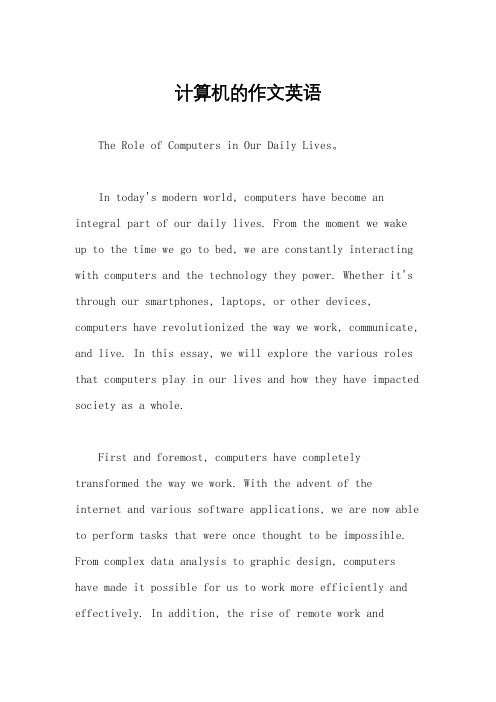
计算机的作文英语The Role of Computers in Our Daily Lives。
In today's modern world, computers have become an integral part of our daily lives. From the moment we wake up to the time we go to bed, we are constantly interacting with computers and the technology they power. Whether it's through our smartphones, laptops, or other devices, computers have revolutionized the way we work, communicate, and live. In this essay, we will explore the various roles that computers play in our lives and how they have impacted society as a whole.First and foremost, computers have completely transformed the way we work. With the advent of theinternet and various software applications, we are now able to perform tasks that were once thought to be impossible. From complex data analysis to graphic design, computers have made it possible for us to work more efficiently and effectively. In addition, the rise of remote work andtelecommuting has been made possible by computers, allowing individuals to work from anywhere in the world.Furthermore, computers have revolutionized the way we communicate with one another. With the rise of social media, email, and instant messaging, we are now able to connectwith people from all over the world in an instant. This has not only made it easier to stay in touch with friends and family, but it has also opened up new opportunities for collaboration and networking. In addition, computers have made it possible for us to access a wealth of informationat our fingertips, allowing us to stay informed and educated on a wide range of topics.Moreover, computers have had a profound impact on the way we live our lives. From online shopping to smart home technology, computers have made it possible for us to streamline our daily tasks and make our lives more convenient. In addition, the rise of artificialintelligence and machine learning has opened up new possibilities for improving our health, safety, and overall well-being. Whether it's through the use of virtualassistants or predictive analytics, computers have the potential to make our lives easier and more efficient.In conclusion, computers have become an essential part of our daily lives, revolutionizing the way we work, communicate, and live. As technology continues to advance, it is likely that computers will play an even greater role in shaping the future of society. It is important for us to embrace these changes and continue to adapt to the ever-evolving world of technology. By doing so, we can harness the power of computers to improve our lives and make the world a better place for future generations.。
计算机英语 作文
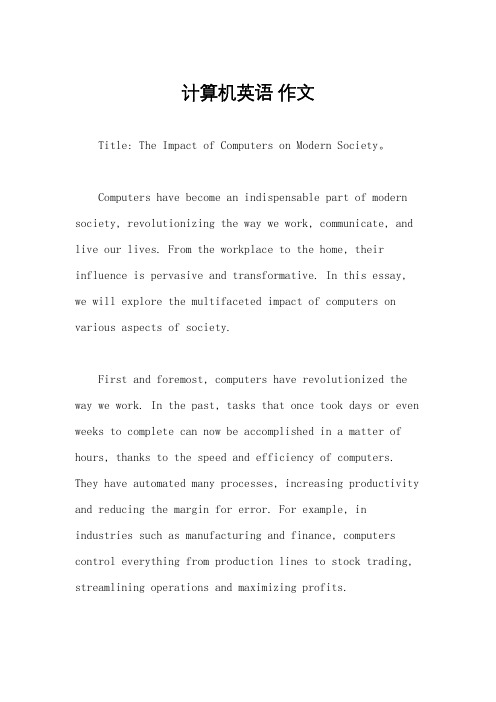
计算机英语作文Title: The Impact of Computers on Modern Society。
Computers have become an indispensable part of modern society, revolutionizing the way we work, communicate, and live our lives. From the workplace to the home, their influence is pervasive and transformative. In this essay, we will explore the multifaceted impact of computers on various aspects of society.First and foremost, computers have revolutionized the way we work. In the past, tasks that once took days or even weeks to complete can now be accomplished in a matter of hours, thanks to the speed and efficiency of computers. They have automated many processes, increasing productivity and reducing the margin for error. For example, in industries such as manufacturing and finance, computers control everything from production lines to stock trading, streamlining operations and maximizing profits.Moreover, computers have democratized access to information. With the advent of the internet, knowledgethat was once confined to libraries and academicinstitutions is now accessible to anyone with an internet connection. This has had profound implications for education, as students can now access a wealth of resources to supplement their learning. Additionally, the rise of e-learning platforms has made education more flexible and accessible, allowing people to learn at their own pace and on their own schedule.Furthermore, computers have transformed the way we communicate. Social media platforms such as Facebook, Twitter, and Instagram have connected people from all corners of the globe, facilitating the exchange of ideas and information on an unprecedented scale. These platforms have also given rise to new forms of expression, such as memes and viral videos, which have become an integral part of contemporary culture. However, it is essential to acknowledge the challenges that come with this newfound connectivity, such as the spread of misinformation and the erosion of privacy.In addition to their impact on work, education, and communication, computers have also revolutionized entertainment. From streaming services like Netflix and Spotify to video games and virtual reality experiences, computers have transformed how we consume media and entertainment. They have made it possible to access a vast array of content at the touch of a button, anytime and anywhere, fundamentally changing the way we entertain ourselves.However, it is essential to recognize that the widespread adoption of computers has also brought about new challenges and concerns. One such concern is the impact of automation on employment. As computers and robots take on more tasks traditionally performed by humans, there is a risk of widespread job displacement, particularly in industries that rely heavily on manual labor. Additionally, there are concerns about the digital divide, whereby those with access to technology benefit disproportionately compared to those without access, exacerbating existing inequalities.In conclusion, computers have had a profound and multifaceted impact on modern society, revolutionizing the way we work, communicate, and entertain ourselves. While their influence has brought about many benefits, such as increased productivity and access to information, it has also raised new challenges and concerns, such as job displacement and the digital divide. As we continue to harness the power of computers, it is essential to consider these implications and work towards creating a more equitable and inclusive society.。
电脑抄数英语作文模板
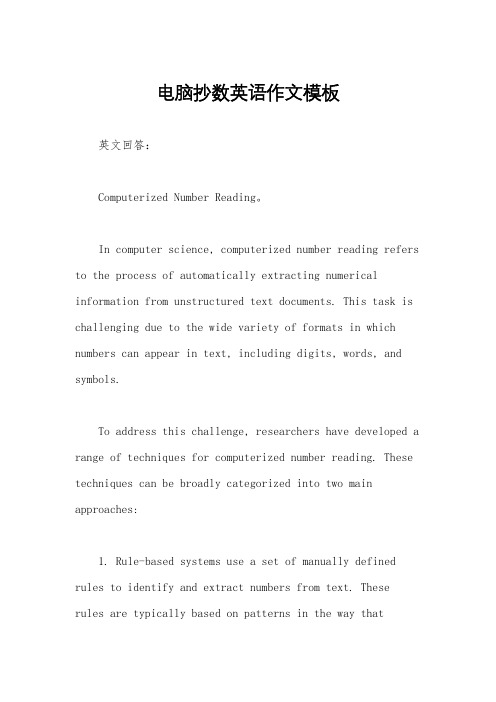
电脑抄数英语作文模板英文回答:Computerized Number Reading。
In computer science, computerized number reading refers to the process of automatically extracting numerical information from unstructured text documents. This task is challenging due to the wide variety of formats in which numbers can appear in text, including digits, words, and symbols.To address this challenge, researchers have developed a range of techniques for computerized number reading. These techniques can be broadly categorized into two main approaches:1. Rule-based systems use a set of manually defined rules to identify and extract numbers from text. These rules are typically based on patterns in the way thatnumbers are written in different contexts.2. Machine learning models are trained on a large dataset of annotated text documents to learn how to identify and extract numbers. These models can be more flexible and accurate than rule-based systems, but they require a significant amount of training data.Computerized number reading has a wide range of applications, including:Data entry。
电脑作文英语

Firstly, let's talk about the evolution of computer technology. Computers have come a long way since the bulky, room-sized machines of the mid-20th century. The development of microprocessors, the invention of the personal computer, and the advancement of networking technology have revolutionized the way we live and work. The rapid pace of innovation in the computer industry has led to the creation of faster, smaller, and more powerful devices, making them accessible to a wider audience.
英语作文 电脑
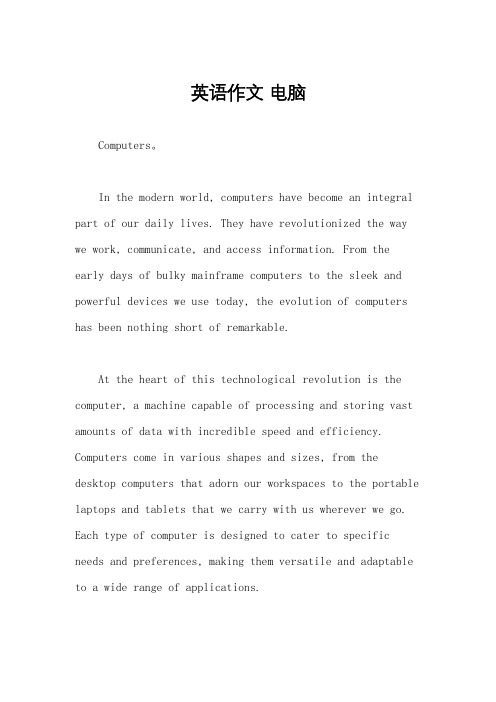
英语作文电脑Computers。
In the modern world, computers have become an integral part of our daily lives. They have revolutionized the way we work, communicate, and access information. From the early days of bulky mainframe computers to the sleek and powerful devices we use today, the evolution of computers has been nothing short of remarkable.At the heart of this technological revolution is the computer, a machine capable of processing and storing vast amounts of data with incredible speed and efficiency. Computers come in various shapes and sizes, from the desktop computers that adorn our workspaces to the portable laptops and tablets that we carry with us wherever we go. Each type of computer is designed to cater to specific needs and preferences, making them versatile and adaptable to a wide range of applications.One of the most significant contributions of computersis their ability to automate and streamline tasks that were once time-consuming and labor-intensive. In the business world, computers have transformed the way we manage finances, track inventory, and communicate with clients. They have enabled companies to operate more efficiently, reduce costs, and increase productivity, ultimately leading to greater profitability and growth.Beyond the business realm, computers have also had a profound impact on our personal lives. They have become essential tools for education, allowing students to accessa wealth of information, collaborate with their peers, and engage in interactive learning experiences. In the realm of entertainment, computers have revolutionized the way we consume media, from streaming movies and TV shows toplaying immersive video games.The rise of the internet has further amplified the capabilities of computers, connecting people across the globe and facilitating instantaneous communication. Email, social media, and video conferencing have become ubiquitous,enabling us to stay connected with friends, family, and colleagues, regardless of geographical barriers.Moreover, computers have played a crucial role in scientific research and technological advancements. They have enabled scientists to model complex systems, analyze vast datasets, and simulate experiments that would be impossible or impractical to conduct in the physical world. This has led to groundbreaking discoveries and innovationsin fields such as medicine, climate research, and space exploration.However, with the increasing reliance on computers, concerns have also emerged regarding data security, privacy, and the potential for technology to disrupt traditional industries and displace human labor. As we continue to integrate computers into every aspect of our lives, it is essential to address these challenges and ensure that the benefits of this technology are distributed equitably and responsibly.In conclusion, computers have undoubtedly transformedthe world we live in, revolutionizing the way we work, learn, and communicate. As technology continues to evolve,it is crucial that we embrace the power of computers while also navigating the ethical and societal implications that come with their widespread adoption. By harnessing the capabilities of these remarkable machines, we can unlock new possibilities and shape a future that is more efficient, connected, and innovative.。
- 1、下载文档前请自行甄别文档内容的完整性,平台不提供额外的编辑、内容补充、找答案等附加服务。
- 2、"仅部分预览"的文档,不可在线预览部分如存在完整性等问题,可反馈申请退款(可完整预览的文档不适用该条件!)。
- 3、如文档侵犯您的权益,请联系客服反馈,我们会尽快为您处理(人工客服工作时间:9:00-18:30)。
commands that allow the user to communicate with the computer. Some
command interpreters are text-oriented, requiring commands to be typed
Operating systems are either single-tasking or multitasking. The more
primitive single-tasking operating systems can run only one process at a
time. For instance, when the computer is printing a document, it cannot start
so a multitasksimultaneously on the CPU. The most common mechanism used to create
this illusion is time-slice multitasking, whereby each process is run
another process or respond to new commands until the printing is
completed.操作系统或者是单一任务处理的,或者是多任务处理的。早期的单一任务处理操作系统每次仅能运行一个进程。例如,当计算机打印文件时,在打印结束之前,计算机不能开始另一个进程或响应新的命令。
All modern operating systems are multitasking and can run several
processes simultaneously. In most computers there is only one central
processing unit (CPU), (the computational and control unit of the computer),
II. How an Os Works操作系统是怎样工作的
Operating systems control different computer processes, such as
running a spreadsheet program or accessing information from the
一Operating System
I. Introduction引言
An operating system (OS), in computer science, is the basic software
that controls a computer. It has three major functions: it coordinates and
oriented interpreters easier to use, but many experienced computer users
prefer text-oriented command interpreters because they are more powerful.操作系统控制不同的计算机进程,如运行一个电子表格程序或访问计算机存储器里的信息。一个重要的进程是解释使用户得以与计算机进行通信的命令。有些命令解释器是面向文本的,要求将命令键入。另一些命令解释器是面向图形的,允许用户通过指向并点击图标,即屏幕上代表具体命令的图片,来进行通信。初学者一般觉得面向图形的解释器使用起来容易一些,但是许多有经验的计算机用户更喜欢使用面向文本的命令解释器,因为它们的功能更强大一些。
manipulates computer hardware, such as computer memory, printers, disks,
keyboard, mouse, and monitor;iety of storage
media, such as floppy disk, hard drive, compact disc, and tape; and it
compact discmanages hardware errors and the loss of data.
在计算机科学中,操作系统(OS)是控制计算机的基本软件。它具有3个主要功能:协调与操作计算机硬件,如计算机存储器、打印机、磁盘、键盘、鼠标和监视器;在各种存储介质上编排文件,如软盘、硬盘、光盘和磁带;以及处理硬件错误和数据丢失.
“bookkeeping” that preserves the state of a suspended process. It also has a
in. Other command interpreters are graphically oriented and let the user
communicate by pointing and clicking on an icon, an on-screen picture that
represents a specific command. Beginners generally find graphically
individually for a fixed period of time. If the process is not completed
within the allotted time, it is suspended and another process is run. This
exchanging of processes is called context switching. The OS performs the
